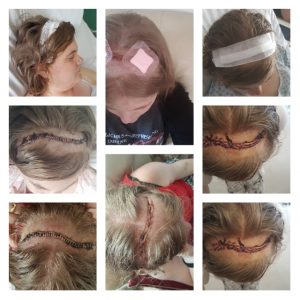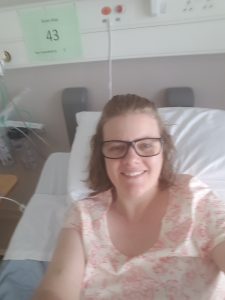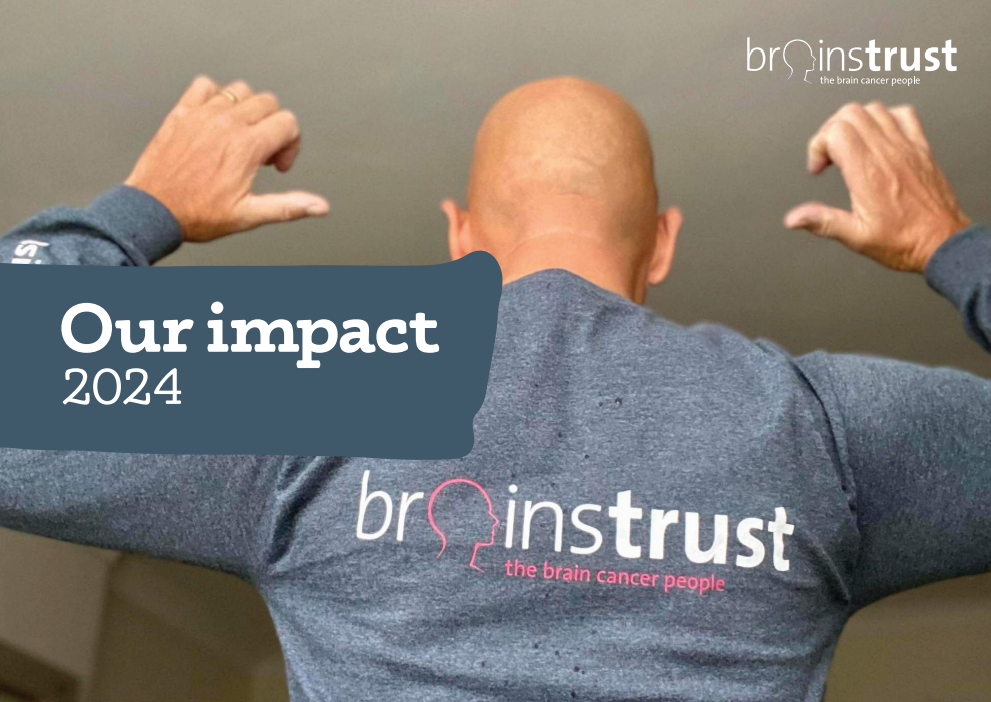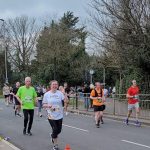The longest lunch break from work
I am writing this two years to the day since my craniotomy and it has been a bit of therapy for me to see where I was and how far I have come. I hope that this also gives you hope with your own fight and battles against brain tumours, no matter what grade or location. The one thing to remember is everyone’s tumour is different and so are their hosts.
The beginning
For a few weeks I began to start feeling different, and doing silly things- or not so silly when you look back and reflect! Suddenly I wasn’t able to park the car; nearly mounting the curb, had absolutely no spatial awareness and was speaking my mind without being able to control what I was saying. One day, I took a lunch break from work and ended up in the walk in centre. After a 5 hour wait, within 20 minutes of my name being called, I was in the main hospital waiting for a CT scan.
The news was delivered to be in a small broom cupboard. The words will always haunt me, “I am sorry but we have found a large mass in your head. We will have to start you on a cocktail of drugs and will not be able to let you go home as we do not know your prognosis”. I took one look at my husband and asked him if he was ok, then said we had better arrange for my sister to stay overnight with the kids. We were told that we could stay in the little room for a few minutes to gather our thoughts. However, two minutes later a nurse knocked on the door and asked us to vacate the room for the next person.
It was around 10pm when I was taken to the ward so my husband had to ask if he would be allowed back in if he went home to get me a few bits. I can remember the feeling of emptiness as the news had not sunk in. I was then given about 8 tablets to take without even knowing what they were or what they were for.
After a number of horrid, lonely days, I was eventually transferred to hospital in Oxford, still in the dark as to what was going on.
One thing I knew was that I wanted life to be as normal as possible (whatever normal means), for my two children who were aged 3 and 10 at the time. I even sent a text to my boss on the Sunday to say that I wouldn’t be in work on Monday and might need a few days off.
Within about 30 minutes of arriving at the JR in Oxford things had been explained to me and I had signed a consent form for a craniotomy the next day. My surgeon had been to see me but by this time my husband had to make the hour journey home to the children. I had to call home and as my husband was still in the car the surgeon made me put the phone on loud speaker and asked him to pull over to a safe place. He then went on to explain the severity of the situation and the reason for the immediate removal.
I was all ready to go down to theatre when a kind nurse came to deliver the news that my ITU bed had been taken by an emergency that came in during the early hours via the air ambulance. My philosophy in life has always been “there is always someone else out there worse off than you”. I was still okay and know that they were right not to start the 10 hour op without knowing that there was a bed at the end for me.
I had not seen the children for nearly a week, but at the time I did not want them to come to the hospital. The second op date came and went again due to another emergency coming in overnight. It was then a big number birthday and I did allow the children to the hospital, where we met in the coffee shop, sang happy birthday and had some cake.

Having surgery
Eventually, after two weeks in hospital, I had my operation. It was touch and go for a while as to whether I had lost the movement in my left side due to the location of my tumour (left frontal) and the fact it was embedded in a main vein.
The night before the operation I had told my husband that I only wanted him in ITU and then when he thought it was appropriate my 10 year old, even before my parents and sister. I needed her to know everything was going to be ok. She was the second family member to see me.
I spent 24 hours in ITU (and have many vivid memories of which now I am sure they were just the drugs talking) then a further 5 days in HDU. I woke up with a catheter which was not expected, due to the lack of movement in my left side. I knew that they would not let me home until I had been to the toilet on my own and potentially walked a little or had my home adapted to suit my situation. My main goal was to get home to the children to give my husband a rest – I know now it was not the right reason, but it worked. I can remember the first day in HDU I was making arrangements with my husband to turn the study downstairs into a make-shift bedroom and have some help aid bars in the bathroom. However day two in HDU the catheter was removed and I had decided to make my own way to the bathroom. The rest is history and I was eventually allowed home.
Coming home
It was a Tuesday and this meant dance lessons for the eldest. I did not want the kids to know I was on my way home so she went to dance like normal and it meant that the baby who by now had not seen me at home for a month, would have me all to herself for an hour.
It was lovely because she was in the bath which gave me time to get settled on the sofa and when she came in her face was a picture. Of course she was interested in the staples nearly ear to ear but she saw them as a hairband ( I did not have any bandages at all). Then I had a little help to get her to bed but was adamant that I would read her a bedtime story, just the two of us.
A few days later I had my staples taken out by the nurse at the GPs and I can remember the looks from the reception staff. Until now (apart from one episode in the hospital) I did not feel any different because no one had commented on them. To be honest I had no energy to even care.
A few days before my follow up appointment I had to make a 999 call, not for me but for my husband. He had broken his ankle in 3 places. When the crew arrived they could not believe what they were coming into! I then ended up changing from being cared for into being the carer, as he couldn’t put any weight on it for 6 weeks. This was the second main turning point for me because if I was to keep up the ‘normal’ for the kids then I would have to do the school/nursery drop off and pickups.
At my follow up appointment, I found out that my tumour was not grade 1 as initially thought but grade 2. I also had an internal stitch peeping through so had to stay in for a further two weeks to have it re-opened and washed out. Luckily this time the surgery was only 3 hours long. I was then on a strong course of antibiotics for 7 days. I allowed the kids to come and visit me in hospital this time as it was the second time I had left for an appointment and not come home straight away after.
Treatment
I then had a decision to make, as I found out I had qualified to do the RMOA trial. In short there is not enough evidence one way or the other to ascertain the best course of treatment for grade 2, radiotherapy or watch and wait for re growth. After a week of hell I decided along with my husband that I would not sign up for the trial because I was not sure if I wanted to have radiotherapy and there was a 50/50 chance that is the route I would be given.
Over the next year I went back to work (the 1 hour lunch break had turned into 5 months!), only on a few hours a day to begin with, slowly building it up over a 6 month period up to full time again. I got a lift into work and walked the nearly three miles home come rain or shine, sleet and snow. Everyday my work colleges would ask if I wanted a lift home and much to their annoyance I would say no. It was character building for me and my way of still keeping a little independence without the driving license. My time to think and clear my head. On the upside it got me fit and I lost just under 4 stone.
My hair became very brittle even though I was not any drugs or had radiotherapy, I could not understand why. I felt quite alone and tried to contact the hospital for advice. I even went to the GP who offered no advice at all. Now I know that it was probably stress induced which was ironically made worse when trying to understand why.
The Children
After I had my second operation, this affected my youngest for about a year after. She did not like me going to the doctors as she thought I wasn’t coming back. When I eventually went back to work and was dropped off in the morning, she would have to see me walk into work otherwise she would have a meltdown when being dropped off at nursery. I often wonder if I should have got her counselling but at the time thought she was too young to understand. Whether this was right or wrong I still do not know, but I made the right choice at the time.
My eldest had support from the school from day one with a pastoral care supporter. When it came to the school holidays I was concerned that she would miss them: I firmly believe that it is important for children to be able to talk to someone who is not connected to the family, that way they can talk freely without worrying they are going to upset anyone. I was advised by a friend that when she went through breast cancer the local Macmillan department at the hospital had a nurse who specialized in taking to children.
Even though she did not know my case the Macmillan nurse agreed to talk to the eldest. I took her to the hospital and she was in a nice environment for over two hours talking about stuff and doing drawings and other stuff whilst I sat outside. Other family members wanted to know what was discussed but I was adamant that we should not ask. To this day I have not asked what they talked about and will not.
Did you know that we have an arm dedicated to supporting children and families impacted by a brain tumour diagnosis? If your child has a brain tumour, or if you have a brain tumour and think your child would benefit from some support, get in touch with Khadijha, our Support Specialist for Children and Families.
Where am I now?
I have my up and down days like everyone and often wonder if I should have counselling myself, but as it stands today I would like to think that if you meet me you would not be able to tell.
There are little tell tail signs like the fatigue and slurred speech every now and again (although friends and family say they cannot tell) and I cannot control my emotions (which as a control freak, is the worst). When I feel frustrated I try and take myself away from the situation.
I have not had any medication since about 4 weeks post-surgery. I have my license back for a year and will have to re-apply again soon, although I do not drive as much as I used to. I am back working full time and have resumed all Mum duties at home.
I always tell friends when they are having babies, loads of people will tell you what to do and how to raise your children. Listen to everyone but make your own decisions as to which pieces of advice to take and or ignore. The same principles go for any of you reading this: you may read 10 stories, all completely different, but each have will have a little something relevant to your condition or experience.








